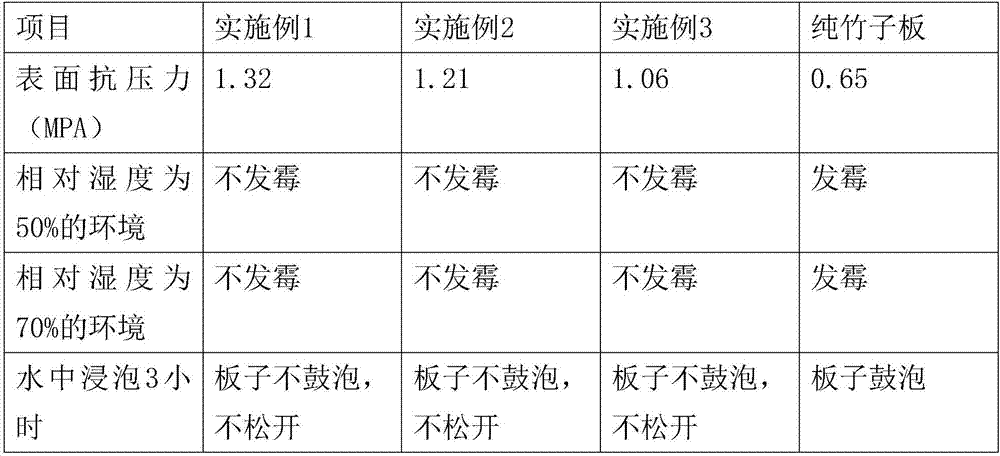Manufacturing process for pine bamboo board
A manufacturing process, bamboo board technology, applied in the direction of manufacturing tools, joining of wooden veneers, flat products, etc., can solve the problems of shortened service life of packaging boxes, poor nail holding force, high hardness, etc., and achieve high resistance to pressure. , Good nail holding force, good weather resistance
- Summary
- Abstract
- Description
- Claims
- Application Information
AI Technical Summary
Problems solved by technology
Method used
Image
Examples
Embodiment 1
[0021] A process for making pine and bamboo boards. The pine and bamboo boards are made of particle board 1 and bamboo fiberboard 2 which are glued at intervals; particle board 1 is made of wood sheets bonded layer by layer, and bamboo fiber board 2 is made of bamboo (bamboo yellow strips can be used). The bamboo flakes are bonded layer by layer, which can be sandwiched by three-layer particle board and two-layer bamboo fiberboard and fixed by adhesive glue.
[0022] The production process of particleboard is as follows: dry the veneer to make the moisture content not greater than 3.5%, then soak the veneer with 8.3% alcohol, soak for 1-5 hours, send the veneer to a high-temperature dryer for high-temperature drying of the veneer , The dried high-temperature veneer will be sent to -30℃ cold storage within 5 seconds to quickly cool down. When the veneer temperature drops to -30℃, then take out the veneer, plan the veneer into 0.2-0.3mm thick wood chips, and then cut the wood chips ...
Embodiment 2
[0025] A process for making pine and bamboo boards. The pine and bamboo boards are made of particle board 1 and bamboo fiberboard 2 which are glued at intervals; particle board 1 is made of wood sheets bonded layer by layer, and bamboo fiber board 2 is made of bamboo (bamboo yellow strips can be used). The bamboo flakes are bonded layer by layer, which can be sandwiched by three-layer particle board and two-layer bamboo fiberboard and fixed by adhesive glue.
[0026] The production process of particleboard is as follows: dry the veneer to make the moisture content not greater than 3.5%, then soak the veneer with 8.3% alcohol, soak for 1-5 hours, send the veneer to a high-temperature dryer for high-temperature drying of the veneer , The dried high-temperature veneer will be sent to -30℃ cold storage within 5 seconds to quickly cool down. When the veneer temperature drops to -30℃, then take out the veneer, plan the veneer into 0.2-0.3mm thick wood chips, and then cut the wood chips ...
Embodiment 3
[0029] A process for making pine and bamboo boards. The pine and bamboo boards are made of particleboard 1 and bamboo fiberboard 2 by gluing spaced apart; particleboard 1 is made of wood fiber powder, mixed with a binder and compacted by applying a certain pressure, and bamboo fiberboard 2 is made of bamboo. The processed residual material (bamboo yellow stripe can be selected) is crushed and then mixed with a binder and compacted by applying a certain pressure. The bamboo fiberboard on both sides can be sandwiched by three-layer particleboard and fixed by adhesive glue.
[0030] The production process of particleboard is as follows: dry the veneer to make the moisture content not more than 3.5%, then soak the veneer with 8.3% alcohol, and then send the veneer to a high-temperature dryer for high-temperature drying of the veneer after soaking for 5 hours. The dried high-temperature veneer will be sent to the -30℃ cold storage within 5 seconds to quickly cool down. When the veneer ...
PUM
| Property | Measurement | Unit |
|---|---|---|
| Thickness | aaaaa | aaaaa |
| Thickness | aaaaa | aaaaa |
Abstract
Description
Claims
Application Information
 Login to View More
Login to View More - R&D
- Intellectual Property
- Life Sciences
- Materials
- Tech Scout
- Unparalleled Data Quality
- Higher Quality Content
- 60% Fewer Hallucinations
Browse by: Latest US Patents, China's latest patents, Technical Efficacy Thesaurus, Application Domain, Technology Topic, Popular Technical Reports.
© 2025 PatSnap. All rights reserved.Legal|Privacy policy|Modern Slavery Act Transparency Statement|Sitemap|About US| Contact US: help@patsnap.com


